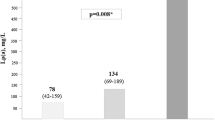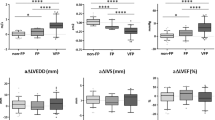Abstract
Calcific aortic valve disease (CAVD) is a common cardiovascular disorder of high social significance. This study aimed to identify independent predictors of hemodynamic progression of CAVD. The relationship between some risk factors, including the rs10455872 polymorphism in the intron 25 of the lipoprotein(a) [Lp(a)] coding region and the plasma Lp(a) concentration, and CAVD severity were prospectively examined in 114 patients. Age (p = 0.023), smoking (p = 0.038), lack of obesity (p = 0.005), triglyceride levels (p = 0.039), and plasma Lp(a) (p < 0.0001) levels were found to be significant determinants of stenosis progression. The rs10455872 polymorphism; however, was not found to be a significant factor for neither the stenosis severity (p = 0.773) nor for plasma Lp(a) levels (p = 0.617). We established a highly significant Lp(a) cut-off concentration (21.2 mg/dL) distinguishing the aortic valve calcification without stenosis from the significant stenosis. Plasma Lp(a) concentration was the only independent predictor of disease progression (p < 0.0001). Moreover, patients with plasma levels of Lp(a) ≥ 21.2 mg/dL were 55 times more likely to develop aortic valve stenosis. We conclude that Lp(a) concentration may prove valuable for more reliable identification of patients at risk of accelerated CAVD development. Future studies are desirable to determine whether plasma Lp(a) levels could be used as a potential biomarker for aortic stenosis progression.



Similar content being viewed by others
Reference
Rosenhek R, Binder T, Porenta G et al (2000) Predictors of outcome in severe, asymptomatic aortic stenosis. N Engl J Med 343(9):611–617. https://doi.org/10.1056/nejm200008313430903
Otto CM, Lind BK, Kitzman DW, Gersh BJ, Siscovick DS (1999) Association of aortic-valve sclerosis with cardiovascular mortality and morbidity in the elderly. N Engl J Med 341(3):142–147. https://doi.org/10.1056/nejm199907153410302
Mohler ER, Sheridan MJ, Nichols R, Harvey WP, Waller BF (1991) Development and progression of aortic valve stenosis: atherosclerosis risk factors—a causal relationship? A clinical morphologic study. Clin Cardiol 14(12):995–999. https://doi.org/10.1002/clc.4960141210
Aronow WS, Schwartz KS, Koenigsberg M (1987) Correlation of serum lipids, calcium and phosphorus, diabetes mellitus, aortic valve stenosis and history of systemic hypertension with presence or absence of mitral anular calcium in persons older than 62 years in a long-term health care facility. Am J Cardiol 59(4):381–382. https://doi.org/10.1016/0002-9149(87)90827-7
Stewart BF, Siscovick D, Lind BK et al (1997) Clinical factors associated with calcific aortic valve disease fn1. J Am Coll Cardiol 29(3):630–634. https://doi.org/10.1016/s0735-1097(96)00563-3
Faggiano P, Antonini-Canterin F, Baldessin F, Lorusso R, D'Aloia A, Dei Cas L (2006) Epidemiology and cardiovascular risk factors of aortic stenosis. Cardiovasc Ultrasound 4:27. https://doi.org/10.1186/1476-7120-4-27
Katz R, Wong ND, Kronmal R et al (2006) Features of the metabolic syndrome and diabetes mellitus as predictors of aortic valve calcification in the multi-ethnic study of atherosclerosis. Circulation 113(17):2113–2119. https://doi.org/10.1161/circulationaha.105.598086
Kamstrup PR, Benn M, Tybjaerg-Hansen A, Nordestgaard BG (2008) Extreme lipoprotein (a) levels and risk of myocardial infarction in the general population: the Copenhagen City Heart Study. Circulation 117(2):176–184. https://doi.org/10.1161/circulationaha.107.715698
Kamstrup PR, Tybjaerg-Hansen A, Steffensen R, Nordestgaard BG (2009) Genetically elevated lipoprotein (a) and increased risk of myocardial infarction. JAMA 301(22):2331–2339. https://doi.org/10.1001/jama.2009.801
Erqou S, Thompson A, Di Angelantonio E et al (2010) Apolipoprotein (a) isoforms and the risk of vascular disease: systematic review of 40 studies involving 58,000 participants. J Am Coll Cardiol 55(19):2160–2167. https://doi.org/10.1016/j.jacc.2009.10.080
Arsenault BJ, Boekholdt SM, Dubé MP et al (2014) Lipoprotein (a) levels, genotype and incident aortic valve stenosis: a prospective Mendelian randomization study and replication in a case-control cohort. Circ Cardiovasc Genet 7(3):304–310. https://doi.org/10.1161/circgenetics.113.000400
Boerwinkle E, Leffert CC, Lin J, Lackner C, Chiesa G, Hobbs HH (1992) Apolipoprotein (a) gene accounts for greater than 90% of the variation in plasma lipoprotein (a) concentrations. J Clin Invest 90(1):52–60. https://doi.org/10.1172/jci115855
Schmidt K, Noureen A, Kronenberg F, Utermann G (2016) Structure, function, and genetics of lipoprotein (a). J Lipid Res 57(8):1339–1357. https://doi.org/10.1194/jlr.R067314
Gotoh T, Kuroda T, Yamasawa M et al (1995) Correlation between lipoprotein (a) and aortic valve sclerosis assessed by echocardiography (the JMS Cardiac Echo and Cohort Study). Am J Cardiol 76(12):928–932. https://doi.org/10.1016/s0002-9149(99)80263-x
Owens DS, Katz R, Johnson E et al (2008) Interaction of age with lipoproteins as predictors of aortic valve calcification in the multi-ethnic study of atherosclerosis. Arch Intern Med 168(11):1200–1207. https://doi.org/10.1001/archinte.168.11.1200
Owens DS, Katz R, Takasu J, Kronmal R, Budoff MJ, O'Brien KD (2010) Incidence and progression of aortic valve calcium in the Multi-ethnic Study of Atherosclerosis (MESA). Am J Cardiol 105(5):701–708. https://doi.org/10.1016/j.amjcard.2009.10.071
Owens DS, O’Brien KD (2014) Clinical and genetic risk factors for calcific valve disease. In: Otto CM, Bonow RO (eds) Valvular heart disease: a companion to Braunwald’s heart disease, 4th edn. Elsevier Science, Philadelphia, pp 53–62
Thanassoulis G, Campbell CY, Owens DS et al (2013) Genetic associations with valvular calcification and aortic stenosis. N Engl J Med 368(6):503–512. https://doi.org/10.1056/nejmoa1109034
Thanassoulis G (2016) Lipoprotein(a) in calcific aortic valve disease: from genomics to novel drug target for aortic stenosis. J Lipid Res 57(6):917–924. https://doi.org/10.1194/jlr.R051870
Rashedi N, Otto CM (2015) Aortic stenosis: changing disease concepts. J Cardiovasc Ultrasound 23(2):59–69. https://doi.org/10.4250/jcu.2015.23.2.59
Chan KL, Teo K, Dumesnil JG, Ni A, Tam J, ASTRONOMER Investigators (2010) Effect of lipid lowering with rosuvastatin on progression of aortic stenosis: results of the aortic stenosis progression observation: measuring effects of rosuvastatin (ASTRONOMER) trial. Circulation 121:306–314. https://doi.org/10.1161/CIRCULATIONAHA.109.900027
Capoulade R, Yeang C, Chan KL et al (2018) Association of mild to moderate aortic valve stenosis progression with higher lipoprotein (a) and oxidized phospholipid levels: secondary analysis of a randomized clinical trial. JAMA Cardiol 3(12):1212–1217. https://doi.org/10.1001/jamacardio.2018.3798
Zheng KH, Tsimikas S, Pawade T et al (2019) Lipoprotein (a) and oxidized phospholipids promote valve calcification in patients with aortic stenosis. J Am Coll Cardiol 73(17):2150–2162. https://doi.org/10.1016/j.jacc.2019.01.070
Mathieu P, Boulanger MC (2014) Basic mechanisms of calcific aortic valve disease. Can J Cardiol 30(9):982–993. https://doi.org/10.1016/j.cjca.2014.03.029
Pomerance A, Darby AJ, Hodkinson HM (1978) Valvular calcification in the elderly: possible pathogenic factors. J Gerontol 33(5):672–675. https://doi.org/10.1093/geronj/33.5.672
Lindroos M, Kupari M, Valvanne J, Strandberg T, Heikkilä J, Tilvis R (1994) Factors associated with calcific aortic valve degeneration in the elderly. Eur Heart J 15(7):865–870. https://doi.org/10.1093/oxfordjournals.eurheartj.a060602
Porras AM, McCoy CM, Masters KS (2017) Calcific aortic valve disease: a battle of the sexes. Circ Res 120(4):604–606. https://doi.org/10.1161/CIRCRESAHA.117.310440
Cosmi JE, Kort S, Tunick PA et al (2002) The risk of the development of aortic stenosis in patients with “benign” aortic valve thickening. Arch Intern Med 162(20):2345–2347. https://doi.org/10.1001/archinte.162.20.2345
Yu B, Hafiane A, Thanassoulis G et al (2017) Lipoprotein (a) induces human aortic valve interstitial cell calcification. JACC Basic Transl Sci 2(4):358–371. https://doi.org/10.1016/j.jacbts.2017.03.015
Krempler F, Kostner GM, Bolzano K, Sandhofer F (1980) Turnover of lipoprotein (a) in man. J Clin Invest 65(6):1483–1490. https://doi.org/10.1172/JCI109813
Rader DJ, Cain W, Ikewaki K et al (1994) The inverse association of plasma lipoprotein (a) concentrations with apolipoprotein (a) isoform size is not due to differences in Lp (a) catabolism but to differences in production rate. J Clin Invest 93(6):2758–2763. https://doi.org/10.1172/JCI117292
Brunner C, Lobentanz EM, Pethö-Schramm A et al (1996) The number of identical kringle IV repeats in apolipoprotein(a) affects its processing and secretion by HepG2 cells. J Biol Chem 271(50):32403–32410. https://doi.org/10.1074/jbc.271.50.32403
Lobentanz EM, Krasznai K, Gruber A et al (1998) Intracellular metabolism of human apolipoprotein(a) in stably transfected HepG2 cells. Biochemistry 37(16):5417–5425. https://doi.org/10.1021/bi972761t
Perombelon YF, Soutar AK, Knight BL (1994) Variation in lipoprotein(a) concentration associated with different apolipoprotein(a) alleles. J Clin Invest 93(4):1481–1492. https://doi.org/10.1172/jci117126
Mooser V, Mancini FP, Bopp S et al (1995) Sequence polymorphisms in the apo(a) gene associated with specific levels of Lp(a) in plasma. Hum Mol Genet 4(2):173–181. https://doi.org/10.1093/hmg/4.2.173
Mooser V, Scheer D, Marcovina SM et al (1997) The Apo(a) gene is the major determinant of variation in plasma Lp(a) levels in African Americans. Am J Hum Genet 61(2):402–417. https://doi.org/10.1086/514851
Tsimikas S (2019) Potential causality and emerging medical therapies for lipoprotein (a) and its associated oxidized phospholipids in calcific aortic valve stenosis. Circ Res 124(3):405–415. https://doi.org/10.1161/CIRCRESAHA.118.313864
Tomova V, Alexandrova M, Atanasova M, Rashev T, Tzekova M (2018) Polymorphism Rs10455872 at the lipoprotein(a) gene locus enhances the risk of aortic valve disease. J Cardiol Cardiovasc Ther 9(4):555766. https://doi.org/10.19080/jocct.2018.09.555767
Catapano AL, Graham I, De Backer G et al (2016) ESC/EAS Guidelines for the management of dyslipidaemias: the task force for the management of dyslipidaemias of the European Society of Cardiology (ESC) and European Atherosclerosis Society (EAS) developed with the special contribution of the European Association for Cardiovascular Prevention & Rehabilitation (EACPR). Eur Heart J 37:2999–3058. https://doi.org/10.1093/eurheartj/ehw272
Acknowledgements
This work was supported by Medical University Pleven (Project No 6/2015), Pleven, Bulgaria, which is greatly appreciated.
Funding
None.
Author information
Authors and Affiliations
Corresponding authors
Ethics declarations
Conflict of interest
None of the authors has any potential financial or commercial conflict of interest associated with this research manuscript.
Ethical approval
This study was approved by the Research Ethics Commission of Medical University—Pleven, Bulgaria.
Informed consent
Informed consent was obtained from all individual participants included in the study.
Additional information
Publisher's Note
Springer Nature remains neutral with regard to jurisdictional claims in published maps and institutional affiliations.
Rights and permissions
About this article
Cite this article
Tomova, V.D., Alexandrova, M.L., Atanasova, M.A. et al. Plasma lipoprotein(a) concentration as an independent predictor of hemodynamic progression of aortic valve stenosis. Mol Cell Biochem 472, 199–207 (2020). https://doi.org/10.1007/s11010-020-03797-5
Received:
Accepted:
Published:
Issue Date:
DOI: https://doi.org/10.1007/s11010-020-03797-5




